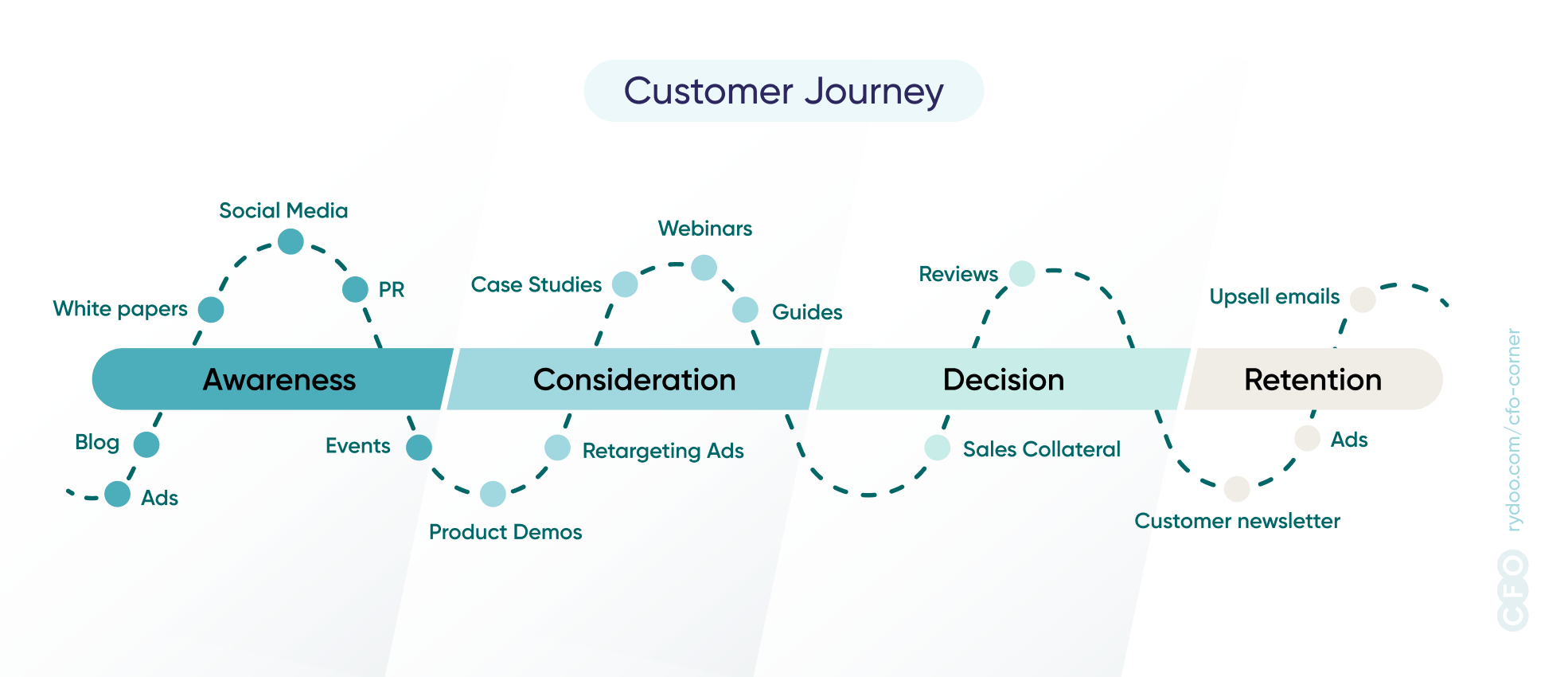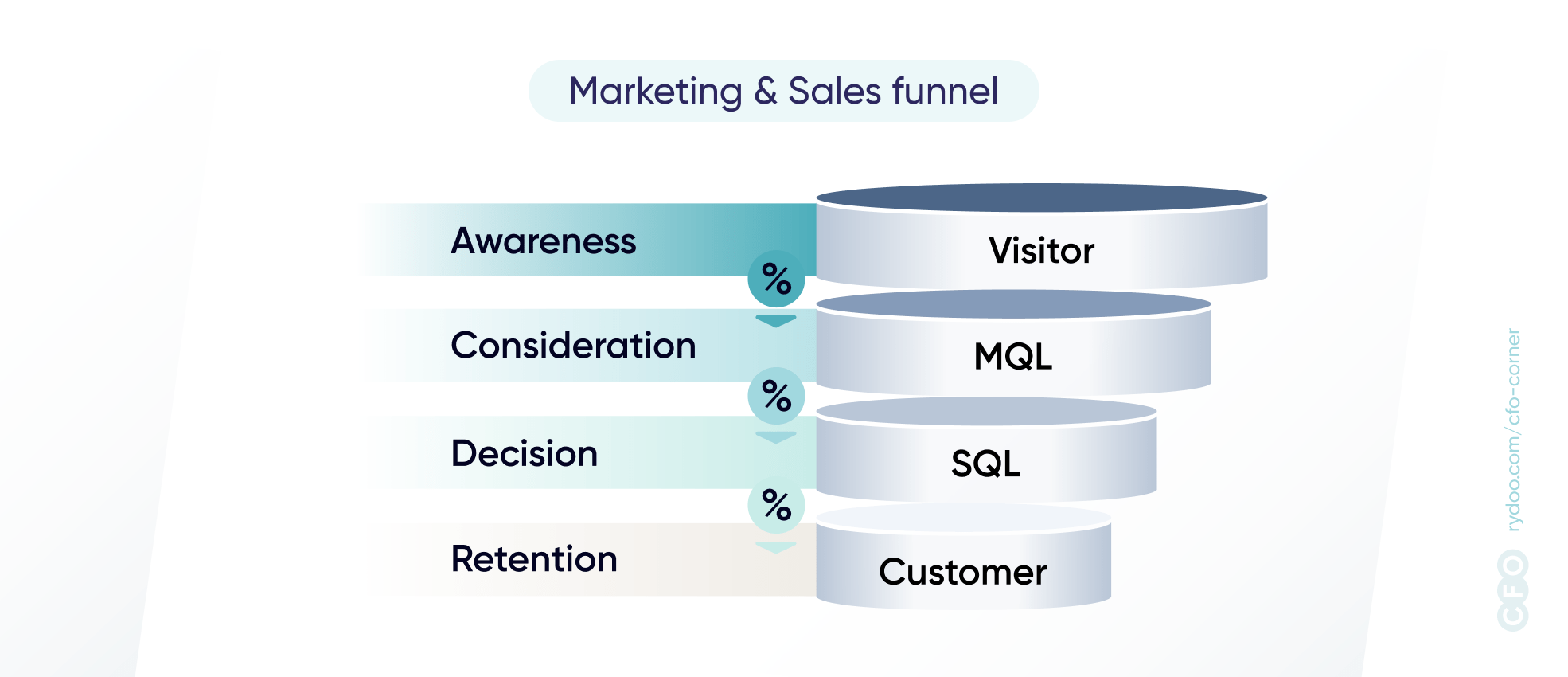For the past seven years, I have been immersed in the dynamic, fast-paced world of B2B SaaS Marketing. Throughout my journey, I have had the privilege of working with various Chief Financial Officers (CFO), each with their unique perspectives, strategies, and understandings of our industry.
However, these collaborations have not always been smooth sailing. In the early stages of my career, I found myself at cross-purposes with CFOs more often than I would have liked. Often there was a disconnect between our separate visions, understandings, and expectations.
With time and experience this picture began to change. As I stepped into the executive shoes myself, I began investing more time in understanding the CFO’s perspective, their concerns and their priorities. Conversations with CFOs transformed from disagreements to productive discussions. We began to speak the same language, driven by a shared understanding of our goals and metrics.
As a Chief Marketing Officer (CMO), I am an advocate for the crucial role marketing plays in driving awareness, engagement and trust. But I am also aware that our efforts are judged through a financial lens — a lens that CFOs, who are primarily concerned with managing costs and driving profitability, are well-acquainted with.
The decisions we make in marketing directly impact the company’s financial performance and vice versa. For instance, a decision to invest in a new customer acquisition campaign will not only affect our marketing plan but also our cash flow and profitability projections.
The aim of this article is twofold. First, to provide a comprehensive understanding of the value marketing brings to our B2B SaaS business, explained in a way that respects and acknowledges the CFO’s financial focus. Second, to propose a framework for CMO-CFO collaboration that not only harmonises our respective objectives but also fuels growth, profitability, and long-term success.
Noël Rauch, CFO at Rydoo agrees that “collaboration between the CFO and CMO is the secret ingredient for fueling the engine of growth, profitability, and long-term success in the B2B SaaS industry. By combining the financial acumen of the CFO with the marketing expertise of the CMO, we can propel our organisation to new heights in the ever-evolving marketplace.”
So, dear CFOs, let’s embark on this journey together, exploring the intersection of marketing and finance and unveiling opportunities for stronger, more effective collaboration.
- The Unique Dynamics of B2B SaaS Business
- The CMO Perspective: Understanding Marketing in B2B SaaS
- Marketing campaigns and channels
- Marketing attribution and ROI
- Retention and expansion
- The CFO Perspective: Balancing Investment and Return in B2B SaaS
- Bridging the Gap: Aligning the CMO and CFO
- Shared Metrics and Goals
The Unique Dynamics of B2B SaaS Business
The Business to Business Software as a Service market is characterised by rapid growth, high customer expectations, and fierce competition. In this space, traditional business models have been replaced by subscription-based models, shifting the focus from one-off sales to ongoing customer relationships. This shift brings new opportunities, but also new challenges.
In the SaaS world, customer acquisition is just the beginning. The real game is in customer retention and expansion. We are no longer just selling a product; we’re selling an ongoing service that must continually prove its value to customers.
From a financial perspective, the subscription model brings a new set of metrics and considerations. Upfront costs are often high, and the return on investment is realised over the length of the customer relationship, which can span several years. This dynamic emphasises the importance of customer lifetime value and churn rates, key metrics that CFOs watch closely.
The role of marketing in the B2B SaaS industry extends far beyond creating brand awareness or generating leads. Our ultimate goal is to drive sustainable growth.

Fernando Amaral
CMO at Rydoo
The CMO Perspective: Understanding Marketing in B2B SaaS
The role of marketing in the B2B SaaS industry extends far beyond creating brand awareness or generating leads. Our ultimate goal is to drive sustainable growth by attracting, retaining, and expanding our customer base. To achieve this, we must design and execute strategies that address the full customer lifecycle.
For startups and scaleups in the B2B SaaS space, customer acquisition is often the primary focus of marketing efforts and a crucial driver of growth. These early-stage companies need to rapidly establish a foothold in the market and demonstrate traction to secure funding and attract talent.
Acquiring a new customer can be a long and complex process, spanning over months or even years, and involving multiple stakeholders. Typically, we can segmented it into three key stages: Awareness, Consideration, and Decision.
Awareness Stage
The awareness stage is the initial phase of the buyer journey, where potential customers first become aware of a problem they have or a need that must be met. In this stage, they are generally not aware of the solutions available or the specific products that could help them.
From a marketing perspective, the primary goal in the awareness stage is to educate the target audience about the problem or need, and make them aware of your company as a potential solution provider. This is typically accomplished through educational content that provides value to the audience, such as blog posts, ebooks, whitepapers, webinars, or social media content.
The awareness stage is also a prime opportunity for brand building. It’s about creating a positive initial impression, establishing your brand as a trusted authority in your field, and differentiating your company from competitors.
Consideration Stage
In the consideration stage, the buyer has a clear understanding of their problem or need, and they are actively considering different solutions. They are researching, comparing, and evaluating different products, services, or vendors to find the one that best meets their requirements.
For marketers, the consideration stage is about demonstrating the value of your product or service. This involves creating content that highlights the features, benefits, and advantages of your offering, such as product demos, case studies, comparison guides, or expert guides.
Decision Stage
In the decision stage the buyer is ready to make a purchase decision. They have narrowed down their options and are comparing the final contenders on specifics like pricing, customer support, or technical specifications.
Marketing’s role in the decision stage is to reinforce the buyer’s choice and facilitate the purchasing process. This could involve providing detailed product specifications, testimonials, reviews, or endorsements. Pricing and package information should be clear and accessible.
Remember that the buyer’s journey is not always linear, and buyers may move back and forth between stages. Furthermore, the duration of the journey can vary greatly depending on the complexity and cost of the product, as well as the specific characteristics of the buyer.
Marketing campaigns and channels
Marketing activities are often called “campaigns” and they run on a variety of channels.
The choice of channels largely depends on the target audience, budget, and specific goals of the marketing campaign. For instance, a startup with a limited budget might focus on organic online channels to build awareness, while a larger, more established company might invest in a mix of paid, earned, and organic channels to reach a broader audience.
Successful demand generation often involves a multi-channel approach, where different channels complement each other and create multiple touchpoints with the audience. Understanding this diversity of channels and how they can be effectively leveraged is key for CFOs to appreciate the complexity and potential of marketing investments.
Organic channels
Organic channels refer to those where visibility and traffic are earned through non-paid means. Search Engine Optimization (SEO) is a prime example, where the goal is to rank high on search engine results pages for relevant keywords. Social media, where brands build a following and engage with their audience on platforms like LinkedIn, Twitter, or Facebook, is another important organic channel.
Organic offline channels include word-of-mouth, where satisfied customers or partners recommend your product or service to others. Networking at industry events or conferences can also generate organic interest and leads.
Earned channels
Earned channels involve third-party recognition or endorsement without direct payment or prompting. This includes press coverage in print or online media, speaking engagements at events, positive reviews, social shares, or guest posts on industry blogs.
These opportunities are typically earned through the brand’s reputation, thought leadership, or public relations efforts.
Paid channels
Paid online channels involve directly paying for visibility or traffic. This can include Pay-Per-Click (PPC) advertising on search engines, social media advertising, display ads, sponsored content, and affiliate marketing.
Paid offline channels can include traditional advertising in print, radio, or television. Sponsorships or exhibitor booths at industry events also fall under this category.

Marketing attribution and ROI
Now that the context has been set, we get to the part that CFOs really care about: understanding what is the impact of each marketing activity on the costs and revenue.
Over 100 years ago, John Wanamaker supposedly said “Half the money I spend on advertising is wasted; the trouble is I don’t know which half.” In the 21st century, with digital advertising and marketing automation tools that track every click of the mouse, such a statement is not easily accepted anymore.
It’s true that in some channels, for very transactional direct marketing campaigns, we can measure the ROI precisely. However, marketing attribution is still the holy grail for B2B marketers who sell to enterprise customers with multiple stakeholders and long sales cycles.
CMOs and CFOs alike would love to know precisely how each marketing investment contributes to the end goal, but there are so many factors influencing one deal that we often get lost and risk going insane in the search for an answer.
Keeping in mind that no attribution model tells the full story, that marketing is more than just advertising, and that some key touch points cannot be tracked at all, we still have to measure and report on our marketing activities, so let’s dive into it.
In the world of B2B SaaS marketing, there are three main sources of lead generation that can be tracked separately: inbound, outbound, and partner. Each has its unique characteristics and strategies.
Inbound Marketing
Inbound marketing is an approach that involves attracting potential customers to your brand rather than reaching out to them directly. It works by creating valuable content and experiences that pull prospects towards your company and product.
Inbound strategies include SEO, content marketing, social media, blogs, and podcasts. These tactics aim to provide value to the audience, establishing your brand as a trusted resource and authority in your industry.
The primary advantage of inbound marketing is its cost-effectiveness over the long term. Once you’ve created valuable content and optimised it to be found, it can continue to attract and convert leads without additional investment. However, inbound strategies often require considerable time and effort to see results.
Outbound Marketing
Outbound marketing is a more traditional form of marketing where companies initiate the conversation and send their message out to an audience. These tactics are typically more direct than inbound strategies.
Outbound marketing includes methods like cold calling, direct messages, trade shows, and advertising.
While outbound methods can be more expensive and potentially less effective than inbound methods, they can also yield quicker results and are easier to scale. They allow you to target a specific audience and provide more control over the message and timing.
Partner Marketing
Partner marketing involves collaborating with other businesses to co-market products or services. In the B2B SaaS world, this can involve forming alliances with other SaaS providers that offer complementary services, channel partners, or affiliate partners.
Strategies can include co-branded content or events, joint webinars, or reciprocal referrals. The idea is to leverage the strengths and audiences of both partners for mutual benefit.
Successful marketing strategies usually involve a mix of inbound, outbound, and partner marketing.
Retention and expansion
The customer journey doesn’t stop when the first contract is signed. SaaS customers expect ongoing value from the services they subscribe to, which means we must continuously engage, educate, and support them.
Marketing efforts in this area may include customer success initiatives, personalised content, and nurturing programs designed to keep customers satisfied and committed to our solution.
As customers grow and their needs evolve, there is often an opportunity to expand the relationship by upselling or cross-selling additional products or services. To capitalise on these opportunities, marketing must work closely with sales and customer success teams to identify and target customers who are most likely to benefit from additional offerings.
The investment to put in retention and expansion versus acquisition should be inline with the company goals related to revenue growth coming from existing customers, something that the CFO should be very aware of.
The CFO Perspective: Balancing Investment and Return in B2B SaaS
From a CFO’s perspective, every investment should be carefully scrutinised. This involves understanding the costs associated with different marketing channels and initiatives. It’s not just about controlling spending, but about making sure that every dollar spent is driving the maximum possible return.
Noel highlights that “cash flow management is a critical consideration for CFOs in B2B SaaS companies. By aligning marketing investments with projected revenues, we can safeguard the company’s financial stability, sustain operations, and strategically fuel long-term growth.”
This involves understanding the company’s financial position, forecasting future performance, and making strategic decisions about where to invest. When it comes to marketing, this might involve deciding between investing in customer acquisition versus retention, or between different marketing channels or geographies.
Alignment is easier to achieve when both parties are working towards the same goals.

Fernando Amaral
CMO at Rydoo
Bridging the Gap: Aligning the CMO and CFO
The B2B SaaS sales cycle can be lengthy, and it may take time for marketing efforts to translate into closed deals and revenue. By maintaining a long-term perspective and supporting marketing initiatives that contribute to sustainable growth, CFOs can help their organisations thrive in the competitive B2B SaaS market.
Given the interconnectedness of marketing and finance, fostering alignment between the CMO and CFO is not just beneficial—it’s crucial for the success of the organisation.
The following strategies can help to build a stronger partnership between these two key roles:
Open Communication
The first step to alignment is open, regular communication. Both the CMO and CFO should make an effort to understand each other’s perspectives, challenges, and goals.
Collaborative Planning
When it comes to budgeting and planning, the CMO and CFO should work together to allocate resources in a way that supports both marketing and financial objectives. This might involve prioritising certain marketing initiatives over others, scaling up or down based on financial capacity, or exploring new, cost-effective marketing channels.
Cross-functional Understanding
Both the CMO and CFO can benefit from a deeper understanding of each other’s roles and responsibilities. This might involve cross-training, joint presentations, or collaborative projects. The more each side understands about the other’s work, the easier it will be to collaborate and find common ground.
Shared Metrics and Goals
Alignment is easier to achieve when both parties are working towards the same goals. The CMO and CFO should agree on key performance indicators (KPIs) that reflect both marketing and financial objectives. This could include metrics like customer acquisition cost (CAC), customer lifetime value (LTV), marketing ROI, and net revenue retention.
Marketing should provide clear, regular reports on campaign performance, lead generation, and other key metrics. Finance, in turn, should keep marketing informed about financial results and budget utilisation.
Here are the most common KPIs that CMOs and CFOs should be aligned on:
ARR: Annual Recurring Revenue is the king of KPIs in a SaaS business and the ultimate goal is to grow this number.
LTV: Lifetime Value is the total revenue expected from one customer during the duration of their subscription. The more a customer pays and the longer they remain a customer, the higher LTV.
CAC: Customer Acquisition Cost is the average spend in Sales and Marketing required to acquire one new customer.
LTV/CAC: The ratio between the 2 previous KPIs indicates if we’re investing efficiently on customer acquisition.
Leading indicators
Leading indicators are key performance metrics that signal future outcomes. Unlike lagging indicators, which measure results after they’ve occurred, leading indicators provide insights into future performance and offer an opportunity to proactively manage and adjust strategies.
When CFOs create a business plan they need to forecast future revenue and having solid leading indicators is the best way to make accurate predictions.
Lead: A prospect who showed an interest in our product and provided their contact information.
MQL: A Marketing Qualified Lead is a lead that has been deemed qualified to be pursued by the sales team, according to a combination of firmographic and behavioural information.
SQL: A Sales Qualified Lead is an MQL that has been qualified by Sales to become an opportunity.

Pipeline: The Pipeline value is the total potential ARR value associated with sales opportunities
Conversion rates: Marketing and Sales KPIs can be seen as a funnel. From top to bottom there is a conversion rate at each step. Understanding the conversion rates makes the system predictable, and improving them has a big impact on revenue.
I hope this reflection can help build a solid bridge between the CMO and CFO roles. Achieving it is an ongoing process that requires regular communication, transparency in data, shared goals, and a concerted effort to understand each other’s perspectives.
As CFOs, I invite you to join us in this journey. Take the time to understand the nuances of marketing, appreciate the potential of our initiatives, and see the measurable impact we bring. As for us, marketers, let’s continue striving to speak the language of finance, demonstrate the ROI of our efforts, and align our strategies with the financial goals of our organisations.



